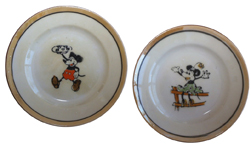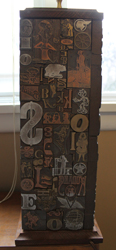 |
|
|||
 |
 |
|||
Copyright © Harry Rinker, LLC 2013 Questions
and Answers QUESTION: I have two (2) four-inch porcelain plates with an orange luster border. The first features a decal of a walking, long-nose Mickey Mouse holding a platter in his right hand that is raised above his head. The second has a decal of Minnie Mouse seated on a fence. The plates are marked “Made in Japan.” They belonged to my grandmother. What is their value? – KD, State College, PA, E-mail Question
ANSWER: Your two plates are from a late 1920s/early 1930s children’s dish set. George Borgfeldt & Company (1881-1962), also known as Geo. Borgfeldt Corporation and Nifty Trade Mark Toys, was headquartered in New York City. From 1928 to 1935, Borgfeldt had a license with Walt Disney to manufacture children’s toys featuring Mickey and Minnie Mouse. [See: http://www.antiquetoycollections.info/products.asp?cat=43] A second source indicates that Roy Disney signed the contract for Disney merchandising with Borgfeldt on February 3, 1930. [See: http://www.bonanza.com/listings/1930s-DISNEY-GEORGE-BORGFELDT-MICKEY-MOUSE-PLATE-2/4089329]. Borgfeldt spent considerable sums fighting those infringing upon his licenses. Initially, Borgfeldt contracted with foreign manufacturers to produced his licensed products. Eventually, Borgfeldt used American manufacturers such as J. Chein and Company. George Borgfeldt & Company became financially insolvent in 1933. Its stock was liquidated. George and Fred Kola reorganized the company as the Geo. Borgfeldt Corporation. The mathematical principle of the whole is equal to the sum of the parts does not work in the antiques and collectibles field. In many cases, the parts are worth more than the whole. Children’s dish sets often do not survive intact. A 21-piece tea set using similar but not identical Mickey and Minnie images contained six cups, six saucers, six dinner plates, creamer, sugar with lid, and teapot with lid. K and M Antiques Store lists this set at $299.99. I found several “Buy It Now” listings on eBay and other websites for plates identical to those that you own listed at $35.00 each. One plate sold through on eBay for $31.00 plus shipping. QUESTION: I have a copy of J. Lee Barrett’s Speed Boat Kings: 25 Years of International Speedboating, published by Arnold Powers, Inc., of New York and Chicago, and showing a Detroit / 1939 imprint on the title page. I bought it for a dollar at a thrift shop. The book is autographed by the author to a Commodore of a boat club. The book has to be worth more than one dollar. What is your opinion? – CV, Hazleton, PA ANSWER: I was only able to locate a minimum of information about J. Lee Barrett. In Chapter 16 entitled “The Teddy Bears in Full Dress: Miss Detroit III and the 1918 Gold Cup Race,” Barrett discussed efforts to power a speed boat with an airplane engine. He notes: “Sportsmen began to buy aircraft engines for marine use. Among those who became interested was Carl Fisher. He had money, sporting blood, the engineering mind. When he left the bicycle business he had made a fortune in Prest-O-Lite. He built the Indianapolis Speedway, experimented with engines at his Indianapolis plant, the Allison Engineering Company.” Fisher and Gar Wood, Sr., one of the owners of Miss Detroit III, decided to form a company to buy some airplane engines from the government. “Wood agreed. We formed the Detroit Marine-Aero Engine Company. The writer [J. Lee Barrett] was appointed general manager….” A reference in The Rudder, Volume 36, February 1920, page 55 notes the J. L. Barrett was a member of the finance committee for the Detroit Yacht Club’s Gold Cup Committee. Abebooks.com contains several listings for the title. The first is for a 1986 reprint, Volume IV of the Michigan Heritage Library. The asking price is $91.96. The Princeton Antiques Bookshop lists several copies of the 1939 hardback edition beginning at $300.00 and ending at $376.00. Condition explains the price differential. Ann Open Book is offering an author signed first edition with a dust jacket for $550.00. Since you make no mention of a dust jacket, I assume you do not have it. Since none of these books listed on abebooks.com has sold, you need to be conservative in estimating the value of your book. Think $350.00 to $375.00. Should the Commodore in question be C. D. Cutting, A. L. Judson, or A. A. Schantz, add another $50.00 to the value. 99.99 percent of the time when a book’s value is researched on abebooks.com, the final result is minimal. It is the other 0.01 percent makes the search process worthwhile. You found a treasure. Now all you need to do is find someone who wants to buy it.
ANSWER: Your lamp is not one-of-a-kind. It is mass produced. I have seen numerous examples in the course of my travels. At first glance, the lamp does appear to be made out of old letter press stamps. As commercial printers switched to computer typesetting in the 1970s and 1980s, their old letter press blocks consisting of letters, number, and images flooded into the secondary antiques and collectibles marketplace. Type drawers became a viable display cabinet when mounted on the wall. Although a manufacturer was able to acquire hundreds of thousands of these blocks, the task of selecting and fitting them snuggly into a 16in x 6in frame was almost impossible. The time cost would have been prohibitive. When examining the photographs that accompanied your email, I looked at the blocks in detail. My first impression was cute, far too cute. Authenticators trust the alarm bell that goes off in their heads. The bell often sounds before the authenticator concludes that something is amiss. When he hears the bell, the authenticator takes a closer look. Examination reveals that the dies on the blocks lack the detail typically associated with a printing block image. Many of the edges have flanges or nicks. The images of people and logos are fuzzy. The conclusion is obvious. While the letter press blocks look believable from a distance, they are not upon close inspection. Your lamp dates from the 1960s/1970s. It was a decorative accessory that complemented the Scandinavian Look. This makes it a candidate for Retro and Modernist collectors. Assuming the light works, has a harp to support the shade, and a shade (ideally a tapered rectangular shape in a solid color), your lamp is worth between $65.00 and 75.00. If the shade is missing, cut the value in half. QUESTION: I have a Model 1894 Spittin’ Image, Lever action BB gun made in Rogers, Arkansas. It is in very good shape and workable condition. I also have the period box and packaging. The BB gun is about 50 years old. What value does it have? – G, Janesville, WI, E-mail Question ANSWER: There are multiple histories of the Daisy BB gun on the internet. What follows is condensed from the website www.daisyking.com. Clarence Hamilton founded the Plymouth Iron Windmill Company in Plymouth, Michigan in 1882. When business declined in the late 1880s, he developed an air rifle prototype. When Leis Cass Hough, the company president, fired the weapon, legend states he proclaimed, “Boy, that’s a daisy!” Initially, the air rifle was given as a premium to farmers who bought a windmill. By 1889, the Plymouth Iron Windmill Company was making more air rifles than windmills. Six years later, the Daisy Manufacturing Company replaced the Plymouth Iron Windmill Company. National fame came in the 1930s when Daisy started producing models such as the Buck Rogers and Buck Jones, capitalizing on the names of comic strip characters and Hollywood stars. The Red Ryder model was introduced in 1940. Daisy moved from Plymouth, Michigan to Rogers, Arkansas in 1958. The line was expanded to include CO2 cartridge weapons and .22 caliber rifles. The “Spittin’ Image” line of BB guns was introduced in 1961. The Model 1894, based on the Model 94 Winchester carbine, became Daisy’s best selling BB gun. The standard asking price for an early 1960s Daisy 1894 Spittin’ Image with it period box ranges from $200.00 to $250.00 in very good or better condition.Harry L. Rinker welcomes questions from readers about
collectibles, those mass-produced items from the twentieth and twenty-first centuries.
Selected letters will be answered in this column.
Harry cannot provide personal answers.
Photos and other material submitted cannot be
returned.
Send your questions to: Rinker on Collectibles, 5955 Mill
Point Court SE, Kentwood, MI 49512.
You also can e-mail your questions to
harrylrinker@aol.com.
Only e-mails containing a full name and mailing address
will be considered.
You can listen
and participate in
WHATCHA GOT?, Harry’s
antiques and collectibles radio call-in show, on Sunday mornings between 8:00 AM
and 10:00 AM Eastern Time.
If you
cannot find it on a station in your area,
WHATCHA GOT?
streams live on the Internet at www.gcnlive.com.
SELL, KEEP OR TOSS?: HOW TO DOWNSIZE A HOME,
SETTLE AN ESTATE, AND APPRAISE PERSONAL PROPERTY
(House of Collectibles, an imprint of Random House Information Group, $17.99),
Harry’s latest book, is available at your favorite bookstore and via
www.harryrinker.com.
|
||||

 QUESTION: I have what I believe to be a one-of-a-kind-lamp. The standard has four sides that measure 16in x 6in. Each side contains a group of letter press stamps mounted onto the lamp. Some of the stamps are quite detailed. The person who made the lamp had to measure each stamp and plot out where it would go on the lamp. What is it worth? – BM, Kent, OH, E-mail Question.
QUESTION: I have what I believe to be a one-of-a-kind-lamp. The standard has four sides that measure 16in x 6in. Each side contains a group of letter press stamps mounted onto the lamp. Some of the stamps are quite detailed. The person who made the lamp had to measure each stamp and plot out where it would go on the lamp. What is it worth? – BM, Kent, OH, E-mail Question.